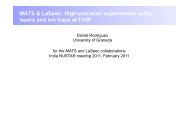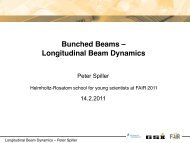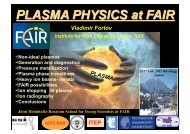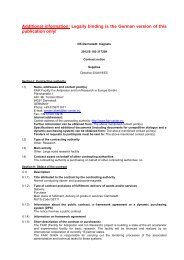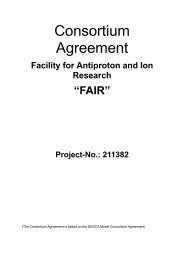CRYRING@ESR - Facility for Antiproton and Ion Research
CRYRING@ESR - Facility for Antiproton and Ion Research
CRYRING@ESR - Facility for Antiproton and Ion Research
Create successful ePaper yourself
Turn your PDF publications into a flip-book with our unique Google optimized e-Paper software.
24 Chapter 6. Proposed Construction Cycle<br />
6.4.3 Electricity<br />
The extension area of the new cave requires the installation of additional lighting. It would<br />
be worthwhile to increase the brightness in the cave by means of coating the rough concrete<br />
surface with white paint. This would also improve the cleanliness in the cave with respect to<br />
the requirements during the opening <strong>and</strong> assembly of UHV components.<br />
The mains voltage distribution <strong>and</strong> 3-phase line connectors have to be installed along ring<br />
<strong>and</strong> beam lines. The total power loss of the installed heat jackets <strong>for</strong> the UHV baking system<br />
would require 210 kW. However, baking will be done partially, i.e. sector by sector. There<strong>for</strong>e<br />
a line connection <strong>for</strong> a maximum consumption of about 100 kW in the cave will be sufficient.<br />
6.4.4 Others<br />
The technical infrastructure of Cave B can be almost unchanged from its present configuration.<br />
The walls, where air conditioning <strong>and</strong> electric lighting are mounted, will not be dismantled.<br />
The same applies <strong>for</strong> the walls bearing the runways <strong>for</strong> two cranes, which are required <strong>for</strong> the<br />
transport of heavy loads inside the cave.<br />
The connection to the pressurized air <strong>and</strong> dry nitrogen systems is already available in the<br />
existing Cave B. The distribution in the new cave is only a small fraction of installation cost<br />
<strong>and</strong> activities.<br />
The planning of a false floor <strong>for</strong> the installation of the power converters will be done as<br />
soon as a detailed arrangement of the supplies has been worked out. It has to be investigated,<br />
whether an impounding basin <strong>for</strong> the cooling water will be necessary or not. The same is the<br />
case concerning the required impounding basin <strong>for</strong> the oil-filled trans<strong>for</strong>mers. Their position,<br />
inside or outside the Target Hall, on the upper or the ground floor, will be decided after working<br />
out the arrangement of all supplies.<br />
6.5 Fast ESR Beam Ejection <strong>and</strong> Transport to CRYRING<br />
The CRYRING can be supplied with decelerated ions from the ESR. The option of decelerating<br />
ions to 4 MeV/u is routinely used in combination with the HITRAP decelerator which is designed<br />
<strong>for</strong> an injection energy of 4 MeV/u. The ESR cycle has been optimized <strong>for</strong> this extraction energy.<br />
As the operation of the ESR is flexible the beam can be decelerated to other energies as well.<br />
The beams which are available are highly charged stable ions, but also rare isotope beams<br />
from the fragment separator FRS can be injected <strong>and</strong> decelerated. An injection energy into<br />
the ESR of 400 MeV/u is favorably chosen in order to profit from the availability of stochastic<br />
cooling which is optimized <strong>for</strong> this energy. At this energy <strong>for</strong> all ions stripping to the bare<br />
charge state is achieved with high efficiency. For lower charge states the injection energy can be<br />
reduced. Cooling after injection at lower energies can be per<strong>for</strong>med by electron cooling which<br />
is slower <strong>for</strong> hot beams, but has also been used in many ESR experiments <strong>and</strong> which results in<br />
even better condition <strong>for</strong> deceleration. The injection energy of 400 MeV/u is sufficiently high<br />
<strong>for</strong> the production <strong>and</strong> storage of rare isotope beams which need an even higher primary beam<br />
energy due to the use of thick production targets <strong>and</strong> the energy loss in the target.<br />
Independent of the injection energy the st<strong>and</strong>ard ESR deceleration cycle employs electron<br />
cooling at an intermediate level of 30 MeV/u. The cooling provides best conditions <strong>for</strong> efficient<br />
deceleration <strong>and</strong> the intermediate flat top in the magnetic cycle is used <strong>for</strong> changing the rf<br />
frequency from harmonic number h = 2 to h = 4. This change is necessary due to the limited<br />
frequency tuning range of the rf system. The deceleration to 4 MeV/u is done with harmonic<br />
number h = 4. At 4 MeV/u electron cooling is applied again in order cool the beam to small<br />
emittance <strong>and</strong> momentum spread which eases the transfer to a subsequent accelerator.



